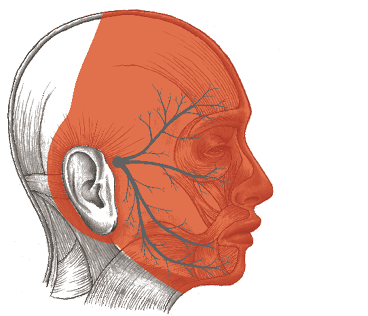In cooperation with Björn, it is splitted on "Disease is Different" into the sections by organ systems and combined with the real cases of our international testimonial / report archive of the related organ system.
THE NERVOUS SYSTEM
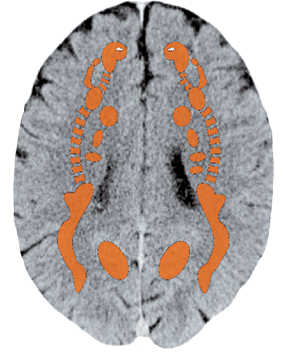
Headaches, migraines I
The most common type of head pain, usually symmetrical, comes from behind, combined with chronic tension.
| Conflict | Moral-intellectual, self-esteem conflict. Perceived injustice, pressure to succeed, dishonesty. Belief that one has to do everything immediately or perfectly. Feeling stupid or unintelligent. Vernacular “Racking your brains.” “Taking it on the chin.” “Hanging your head.” |
|---|---|
| Example |  An office worker has been under stress the whole week because of too much work. She is really looking forward to the weekend. On Friday, as the tension subsides, the headache begins = repair phase of the self-esteem conflict. Note: typical weekend migraine. (Archive B. Eybl). An office worker has been under stress the whole week because of too much work. She is really looking forward to the weekend. On Friday, as the tension subsides, the headache begins = repair phase of the self-esteem conflict. Note: typical weekend migraine. (Archive B. Eybl). |
| Conflict-active | Functional impairment, cell breakdown in cervical vertebrae/cranial bones/ligaments/muscles. |
| Repair phase | Regeneration of the tissue, swelling, pressure on the bone skin > head and neck pain. So, the headaches appear in the context of a repair phase. Recurring conflicts cause an alternation between pain-free intervals and times of headaches. |
| Questions | With what and why do I put myself under pressure? Who do I want to impress? Why does only my performance count? What conditioning lies behind it (father, mother, teacher)? For further questions: see: p. 288f. |
| Therapy | Determine the conflict, conditioning and belief systems and resolve them. Look for the love – there you will find the solution. Guiding principle: “I trust in my abilities.” “I can’t do everything at once. I will calmly accomplish everything I can and that’s it.” “What I can’t change isn’t going to upset me.” See also: therapy for headaches/migraines p. 67. |
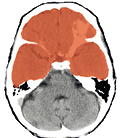
Headaches, migraines II, trigeminal neuralgia
Normally, migraines appear suddenly, are asymmetrical (usually only one side of the face) and are accompanied by intense pain.
The fact that the most common form of migraines are caused by the trigeminal nerve was recognized by Angela Frauenkron-Hoffmann. The following is derived from her excellent book, 1-2-3 Migränefrei (see source list).
The trigeminus has three branches (see illustration p. 92): The upper, first branch, supplies the eye area, the second, essentially the nose and the third, the mouth and tongue. Usually the first branch reacts (migraines in the temple/eye area). As always, the content of the conflict reveals the function:
Headaches
Further, possible causes for headaches
General healing symptom: The cause is the brain’s need for more room (brain/cerebral edema). The pressure on the meninges causes headaches. The brain itself has no pain receptors. Light to medium headache = repair phase. Severe to extreme headache = repair phase crisis.
Following the consumption of certain foods or drinks: For some people, foods are conflict triggers (= allergy). Conflict activity is triggered through consumption. The affected organ must not necessarily be a digestive organ > repair phase = headache.
The result of being poisoned: Most medications, alcohol, nicotine, and other drugs, set the body under artificial stress, making them sympatholytic substances. If the sympathetic nervous system is stimulated, we feel “high.“ The effect of most medications is based on this autonomic shift. Repair phases and the pain associated with them are interrupted. When the poisonous effects diminish, the individual starts healing > repair after the poisoning > headache (for instance, analgesic-headache).
Hypoglycemia of the brain through any repair phase: During the repair phase, especially the repair phase crisis, the brain has a much stronger need for sugar. A low glucose level causes or increases the brain edema > headache. Thus, a regular application of organic glucose in the case of brain pressure symptoms is important for therapy.
Hypoglycemia of the brain, as a result of a fear-revulsion conflict or a refusal conflict, regardless of whether alpha cells or beta cells are affected, can cause a temporary hypoglycemia with headache, according to the phase. (See: p.272)
| Therapy | headache/migraine
|
|---|
Cerebellum
Conflicts Related to: Integrity Injuries,
Attitudes, Attacks and
Worry – among others
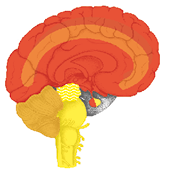
Brainstem
Chunk Conflict
Cerebral Cortex
Social Conflicts
Midbrain
Chunk Conflict, Motor/Peristaltic
Brain tumor (astrocytoma, glioblastoma, oligodendroglioma, ganglioglioma)
About 50% of the brain’s volume consists of brain connective tissue (= glia). The macroglia cells (astrocyte, oligodendrocyte, ependymal and plexus epithelial cells) are a part of the ectoderm and account for 80%.
The other 20% are microglia cells (Hortega cells, mesoglia), come from scavenger cells and are mesodermal.
The nerve cells (neurons) are completely dependent on the interaction with the glia. Without them, nothing would happen in the brain at all.
The historical term, brain connective tissue, hardly does justice to the important function of the glia.
Functions of the macroglia:
1. Networking, stimulus conduction, nourishment, protection, isolation (blood-brain barrier) of the nerve cells.
2. Supplying the web-like mechanical structure.
Incidentally, the functions of the microglia are similar to the scavenger cells in the body: police, fire department and waste management for the brain.
Microglia tumors practically never occur. Our attention is therefore focused on the macroglia: From the functions, you can derive the following conflict content of brain tumors:
| Conflict | 1. Social conflict – one wasn’t connected well enough, one doesn’t feel sufficiently informed or protected by others, one didn’t get enough help from others and therefore got into difficulties or, vice versa, one didn’t provide sufficient help. 2. One can’t deal with structures (e.g., social, economic systems) or fails in constructing sustainable structures (workplace, residence, family). The location of the tumor shows the tone of the conflict. E.g., in the white matter > self-esteem components, in the cerebellum > integrity-injury components (see above). |
|---|---|
| Example |  A 21-year-old, left-handed patient is diagnosed with a “brain tumor“ when she is examined in the hospital after having fainted briefly. A tumor is found in the right ovary relay. Thus, it is a loss conflict in the process of healing. The following occurred 6 years ago: Hexi, the patient‘s beloved poodle mix, is hit by a car. The poor animal lies there, whimpering with a crushed skull. In her shock, the girl, 15 at the time, does not go with her to the vet to have her put to sleep. = Conflict with loss components, that she should have provided support for her dog. In all the years since, whenever she sees a dog, she thinks of Hexi and how she abandoned her in his darkest hour (recurrence). The patient entered into the repair phase five months ago when she got a new dog named Akira. Since then, she no longer thinks about Hexi, but is often tired (vagotonia). The “brain tumor“ shows the healing process. (Archive B. Eybl) A 21-year-old, left-handed patient is diagnosed with a “brain tumor“ when she is examined in the hospital after having fainted briefly. A tumor is found in the right ovary relay. Thus, it is a loss conflict in the process of healing. The following occurred 6 years ago: Hexi, the patient‘s beloved poodle mix, is hit by a car. The poor animal lies there, whimpering with a crushed skull. In her shock, the girl, 15 at the time, does not go with her to the vet to have her put to sleep. = Conflict with loss components, that she should have provided support for her dog. In all the years since, whenever she sees a dog, she thinks of Hexi and how she abandoned her in his darkest hour (recurrence). The patient entered into the repair phase five months ago when she got a new dog named Akira. Since then, she no longer thinks about Hexi, but is often tired (vagotonia). The “brain tumor“ shows the healing process. (Archive B. Eybl) A man comes to the realization that the system in which we live is dishonest. When he tries to get out of it by starting an alternative career (health products), he fails. After he changes things in his life several times, a tumor develops in his cerebral white matter. Due to pressure by his family, he submits to an operation. Nevertheless, he survives. (Archive B. Eybl) A man comes to the realization that the system in which we live is dishonest. When he tries to get out of it by starting an alternative career (health products), he fails. After he changes things in his life several times, a tumor develops in his cerebral white matter. Due to pressure by his family, he submits to an operation. Nevertheless, he survives. (Archive B. Eybl) |
| Conflict-active | Unnoticed diminishing function of the brain’s connective tissue or degeneration of glia. |
| Bio. function | 1. Limitation/degeneration of the old network to make room for the new. 2. Limitation/degradation of the old structure so an alternative can be built (similar to an alternative system). |
| Repair phase | Repair phase: Increase in function and growth of the brain’s connective tissue. Headaches, possible double vision, dizziness due to the swelling. Duration and intensity of growth dependent on the conflict size. Often, a persistent conflict. Estimating the length of the repair phase is difficult due to recurrences going unnoticed and the diagnosis shock. |
| Note | Brain tumors are being diagnosed more frequently, because patients are being scanned more precisely and more frequently (CT, MRI). Earlier, the patient just had headaches for three months. One didn’t know why, but the patient was left to recover in peace. Today’s policy is “action.” Preventative examinations are also responsible for finding more and more tumors that may not result in any complications for the patient and would have been ignored in the past. Less than 2% survive the diagnosis “brain tumor.” Most die of fear, chemotherapy and radiation. This SBS is not the cause of all structures diagnosed as brain tumors: According to Dr. Hamer, a so-”brain tumor” is not an SBS itself, but represents a Hamer focus during or after an intensive repair phase. Thus, he explains brain tumors as not being their own SBSs. In my experience, the SBS described here is running when the connective tissue doesn’t stop growing for months and when the swelling cannot be explained by edema anymore = brain tumors with increasing swelling that would be diagnosed as “malignant” by CM. |
| Questions | When did the symptoms begin? (= Beginning of the repair phase, set off by something positive). What happened that was good? (E.g., good news, reconciliation, praise, vacation, retirement. > Based on the positive event, you can deduce the preceding conflict). Did I feel that I wasn’t supported enough? Was there a lack of important information? Was there stress related to a structure/system? Why was that so important to me? What sensitized me to it (childhood, parents’ emotions, pregnancy, birth)? What further conditioning in the family underlies it? What positive aspects can the diagnosis have? |
| Therapy | The conflict is resolved; support the healing. In the event that the symptoms do not improve, i.e., last longer than 6 months, you’re dealing with a persistent conflict. > Determine the conflict, conditioning and beliefs and resolve them. Find out where the love is – there lies the solution. Knowledge of the 5 Biological Laws of Nature is decisive for someone finding their way out of the fear. For actionable measures, see repair phase – brain level, p. 67. In the case of syndrome: resolve the refugee conflict (see: p.277ff). Cortisone to reduce the swelling as necessary. The surgical removal of brain tumors is only rarely advisable. Chemo and radiation therapy is not recommended based on the low survival rate. As a rule, the ideal therapy for every individual is the one that they trust the most. With this in mind, the decision for chemotherapy, although not to be recommended, should be accepted. |
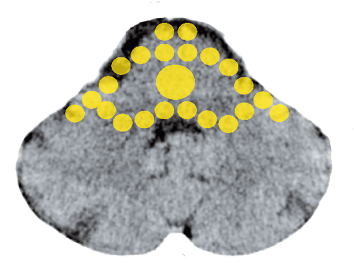
Pineal tumor (pineocytoma, pineoblastoma)1
The pineal gland is a light-receiving organ which produces hormones. It’s interaction with the retina converts the serotonin formed in the brain during the day into melatonin at night.
It controls the circadian (day and night) rhythm and is considered the seat of the 3rd eye. The gift of clairvoyance and intuition are attributed to this mysterious organ. According to Dr. Rick Strassman, it is a window into other areas of our existence.
The following is what little we know so far about the pineal gland from the perspective of the New Medicine:
| Conflict | Chunk conflict (p. 15, 16): Too little light – it’s too dark. Real or in the figurative sense. (The Light of God.) |
|---|---|
| Examples | ➜ One suffers from the absence of natural light (mine or night-shift workers, dark office). ➜ One feels separated from God and forsaken by all the angels. |
| Conflict-active | Increased light absorption and melatonin production. With prolonged conflict activity, enlargement of the gland by cell division. = Pineal tumor. Frequent complications: obstruction of the outflow of cerebrospinal fluid > liquid overpressure > intracranial pressure symptoms, possibly hydrocephalus. |
| Bio. function | Improvement of light reception – to cope with less light. More production of melatonin. |
| Repair phase | Tumor degradation by fungi bacteria. = Pineal tuberculosis > “brain sand” or calcification. |
| Note | Open questions: Why is the pineal gland calcified in almost all people? Does almost everyone experience this conflict? Is a life removed from God responsible or is the truth that calcification is a (positive) crystallization? |
| Therapy | Determine and solve conflict in real life if still active. Pay attention to a good sleep/night rhythm and get adequate sleep. As often as possible, “refuel” sunlight and nature. At sunset, look straight at the sun. Colloidal gold. Meditate, visualize, and be creative. Avoid fluorine, caffeine, sugar and all poisons. Guiding principle: “I am always conscious about my divine descent. Its light shines in me. “ |
11 See Dr. Hamer, my student girl, pp. 469ff, Amici di Dirk Publishers, 2nd edition 6/2014, ISBN 978-84-96127-63-0

Brain tumor of the brain chambers – ependymoma, choroid plexus papilloma1
| Conflict | 1. Right side of the brain: cannot get something, Left side of the brain: cannot get rid of something. 2. Conflict that the brain dries up: One believes that they cannot think well enough. |
|---|---|
| Examples |  For 1: A woman works reluctantly as a secretary at the social welfare court. = Conflict – she wants to leave. When she finds a new job, the ependymoma brain tumor, located in the left lateral ventricle, will break down by tuberculosis (ependymoma- tuberculosis ).1 (Archive B. Eybl) For 1: A woman works reluctantly as a secretary at the social welfare court. = Conflict – she wants to leave. When she finds a new job, the ependymoma brain tumor, located in the left lateral ventricle, will break down by tuberculosis (ependymoma- tuberculosis ).1 (Archive B. Eybl)➜ Someone cannot remember while learning or does not understand the math problems. |
| Conflict-active | Function increase, growth of an arterial network adeno-ca = ependymoma or choroid plexus papilloma. |
| Bio. function | Enlarging the artery network so that more brain fluid can be produced/delivered. |
| Repair phase | Degradation of the tumor by fungi bacteria. = Ependymoma tuberculosis. Afterward, calcium deposits remain. A calcified choroid plexus can often be seen in the CT. |
| Therapy | Determine conflict or triggers and resolve them in real life if still active. |
11 See Dr. Hamer, My Student Girl, pp. 469ff, Amici di Dirk Publishers, 2nd edition 6/2014, ISBN 978-84-96127-63-0
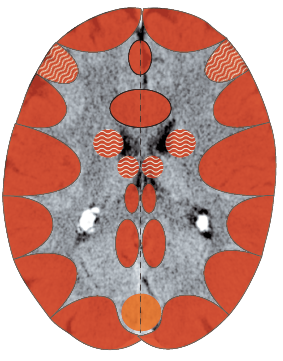
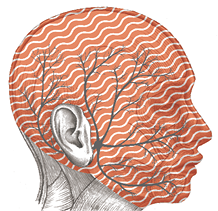
Paralysis of the facial nerve, nervous twitching (tic)
| Conflict | Motor conflict, made the fool. Fear of losing face or being humiliated. |
|---|---|
| Examples | ➜ Somebody disgraces themselves in front of the family, in their circle of friends, or in front of their colleagues at work. ➜ ”Just look at yourself!“ “Ugh! Look at them over there.“  A 62-year-old man has the urge to “convert” all of the people around him: He explains to them why they shouldn’t eat meat, why vaccinations are bad etc., but thanks to his fanaticism, he reaps only ridicule and rejection. = Conflict over being made the fool. A tic develops: His right eye twitches, as if he he’s trying to squint. When he recognizes the cause and realizes he can’t change the world like this, the tic becomes much better. (Archive B. Eybl) A 62-year-old man has the urge to “convert” all of the people around him: He explains to them why they shouldn’t eat meat, why vaccinations are bad etc., but thanks to his fanaticism, he reaps only ridicule and rejection. = Conflict over being made the fool. A tic develops: His right eye twitches, as if he he’s trying to squint. When he recognizes the cause and realizes he can’t change the world like this, the tic becomes much better. (Archive B. Eybl) |
| Conflict-active | Partial or general paralysis of the facial muscles. The most common symptom: on the affected side, the corner of the mouth hangs down. Light cases are common. |
| Bio. function | A paralysis of the facial expressions results in a “poker face“ showing no emotions. In this way, the “game“ can be won in the end. |
| Repair phase | Return of the feeling in the nerves. Note: Sometimes the paralysis does not show itself until the beginning of the repair phase or after the repair phase crisis = hot stroke (see below). |
| Repair crisis | Twitching, cramps In CM, facial paralyses are often seen as “strokes.“ Watch for “handedness.” |
| Questions | When did the symptoms begin? Stress from losing face? Did I feel humiliated or disgraced? What conditioning in the family underlie this? |
| Therapy | See trigeminal neuralgia I. |


Striated Musculature
Motor conflict
Stroke without documented brain hemorrhaging
In the following, we will deal with strokes in which there was no hemorrhaging found in CT/MRI scans. Upon closer inspection however, one will find Hamer foci or edemas in the motor area of the cerebral cortex.
As for the CM claim of an “insufficient oxygen supply to an area of the brain” (ischemic stroke): The blood vessels of all organs, including the brain, are arranged in a network. A potential vessel occlusion (blockage) is immediately detoured by so-called vascular redundancy (collateral circulation) and via new branches forming between adjacent blood vessels (neovascularization). Doctors often search for hemorrhaging to no avail and finally assign responsibility to some blood vessel arbitrarily because they can’t find anything. Conclusion: “ischemic strokes” are questionable.
In the New Medicine, we know of two types of strokes. Both are caused, when paralyses occur, by motor conflicts. The first, less common form, is the so-called cold stroke = paralysis in conflict activity.
The second, much more common form is the so-called hot stroke. This happens during a fulminating repair phase after a very long period (several months, but usually years) of conflict activity.
Cold stroke1
| Conflict | Motor conflict. Fear of restriction. Conflict of not being able, allowed or willing to move. Facial muscles: to be made a fool of. Shoulder/back musculature: to be unable to avoid someone or something. Leg and arm bending and pulling musculature (adductors): To be unable to hold onto something or somebody, to draw him close, to hug him. Leg and arm stretching and splaying musculature (abductors): To be unable to escape from, push away, or fend off somebody or something. Legs in general: To be completely at a loss. To be unable to get away, escape, or catch up. To be unable to run fast enough, climb, go up or down, dance, jump, keep one‘s balance, etc. |
|---|---|
| Tissue | Voluntary (striated) musculature – cerebral cortex – ectoderm (innervation) and cerebral white matter – mesoderm (nutrition). |
| Conflict-active | Paralysis is often just a weakness of the affected muscle group = cold stroke. Signs of sympathectomy such as cold hands, compulsive thinking, light sleep, weight loss, etc. CM normally does not call these paralyses strokes, instead, they go under names like MS (multiple sclerosis) or ALS (amyotrophic lateral sclerosis). |
| Bio. function | The “play dead“ reflex: Many animals pretend to be dead when being chased or when the situation is hopeless (e.g., fawn, mouse, snake). The pursuer then gives up or does not even see his prey. Carnivores – cats, for example – are only interested in “moving objects.“ When the danger has passed, the paralysis ends. |
| Repair phase | Recovery of nerve network. The paralyses only improve gradually because the nerve connections (synapses) in the brain have become overstretched (dissociated) by the healing edema. |
| Repair crisis | Convulsions, cramps, epileptic seizure or multiple seizures. |
| Note | Consider “handedness“ (right or left) and side (mother/child or partner). The muscle groups most affected point to the conflict. For example, if the right adductors are affected in a right-handed patient, it is about the conflict of not being able to hold the partner (people other than the mother and child). Other organs and/or a brain relay can also play a role: If the person‘s speech is impaired, for instance, it is a shock-fright or speechlessness conflict in the repair phase. Memory gaps (absence seizures) can also lead to a diagnosis of stroke = separation conflict in the repair phase crisis. |
| Questions | When did the paralyses begin? (Conflict must have occurred before this). Accident, fall? Events in the family, relationships? What happened spiritually? What was going on in my head at the time? Did I want to run away? Was there someone I couldn’t hold? Conditioning from the family (bad accidents, falls)? |
| Therapy | See remedies for paralysis, p. 379. |
Hot stroke1
Same SBS as above or another SBS, for example, brain edema (repair phase) in the cerebral white matter > compression of the motor function in the adjacent cerebral cortex > motor skills cease to function > CM – “stroke.“
| Examples |  From the beginning, the right-handed patient was brought up strictly by his dominant mother. At his first opportunity, he fled from home. He is an only child and felt responsible for his mother. If he did not visit her often enough, he felt guilty = motor conflict, not being able to shake off his mother. Two years after his mother‘s death, the 59-year-old patient had a stroke, which he barely survived = healing of the motor conflict. Especially affected were the abductors of the arm and leg on the left mother/child-side. (Archive B. Eybl) From the beginning, the right-handed patient was brought up strictly by his dominant mother. At his first opportunity, he fled from home. He is an only child and felt responsible for his mother. If he did not visit her often enough, he felt guilty = motor conflict, not being able to shake off his mother. Two years after his mother‘s death, the 59-year-old patient had a stroke, which he barely survived = healing of the motor conflict. Especially affected were the abductors of the arm and leg on the left mother/child-side. (Archive B. Eybl) For twenty years, the 45-year-old, right-handed patient worked for a company against his will = motor conflict, not being able to go in the direction that he wants to go, not being able to get away from the company. Finally, he resigned so he could open his own business (lifelong dream), but it never came to that. On the very day the business opened, he had a stroke = healing of the motor conflict. Mainly affected is the right partner-side. (Archive B. Eybl) For twenty years, the 45-year-old, right-handed patient worked for a company against his will = motor conflict, not being able to go in the direction that he wants to go, not being able to get away from the company. Finally, he resigned so he could open his own business (lifelong dream), but it never came to that. On the very day the business opened, he had a stroke = healing of the motor conflict. Mainly affected is the right partner-side. (Archive B. Eybl) |
|---|---|
| Phase | Repair phase: Hot hands and feet, increased appetite, possibly fever, dizziness, and headache – signs of vagotonia. The most frequent symptom is a one-sided paralysis of the arm or leg. The Hamer focus in the brain swells up edematous and compresses its surroundings. After years or decades of conflict activity, the repair phase comes to the drama of a stroke. The price to be paid for the long-lasting conflict activity is usually incomplete recovery, sometimes even the death of the patient due to the brain edema. If a CT scan is made, this edema is often wrongly diagnosed as “intracranial bleeding.“ |
| Therapy | In the acute phase: The conflict has been resolved. Support the healing! See: repair phase at the brain level, p. 67. After the acute phase: On the physical level, CM does the right thing: rehabilitation measures – physiotherapy, massage, swimming, etc. Practice, practice, practice, but with the right attitude! From a psychological point of view, the patient has indeed resolved one or more major conflicts; otherwise he wouldn‘t have had a stroke. However, the paralyses or other losses usually mean a new conflict for the patient, especially if rehabilitation progress begins slowly. For example, a motor conflict: “My left leg is worthless now!“ Genital conflict: “I can‘t even do anything in bed anymore.“ “My wife will start looking for somebody else!“ > Accept the situation as it is, but nevertheless, believe in healing and improvement. Resignation is just as bad as expectations that are too high. |
1 See Dr. Hamer, Charts pp. 138, 139, 143, 144

Stroke through brain hemorrhage, cerebral hemorrhage
(intercerebral hemorrhage, subarachnoid hemorrhage)
Bleeding between cranial bones and dura mater (= epidural hemorrhage) and bleeding between the dura mater and the arachnoid mater (= subdural hemorrhage) usually happens by accident (trauma) = no conflict.
A hemorrhage under the arachnoid mater (= subarachnoid hemorrhage) or in the brain itself (= intercerebral hemorrhage) usually occurs without external influences and is considered by conventional medicine to be the main cause of strokes (= hemorrhagic stroke).
If a CT and MRI show that bleeding actually is present, the following conflicts may be present:
| Conflict | Self-esteem conflict. According to Frauenkron-Hoffmann: Can’t count on the intellectual support of the family when something’s on the line or pressure from the family. Otherwise, one can’t understand why a member of the family has gone away (represents the exiting blood). |
|---|---|
| Phase | Cell degradation (necrosis) during conflict activity in the arterial or venous wall, unnoticed as a rule. Through recurring conflicts, the weak points (weak blood vessels) can rupture quite easily. E.g., during physical exertion (high blood pressure is associated with this) or during a brain repair phase in the affected region > bleeding into the brain. |
| Bio. function | Like always, it is only to be recognized in the normally short, two-phase course. However, the cerebral hemorrhaging comes from a chronic process. Here, it reflects the body, what is going wrong internally (psyche). |
| Therapy | Intensive care medical treatment (hospital) at the signs of a stroke, rehab afterwards. Find the conflict and resolve it to prevent further episodes. MMS (see p. 68). |
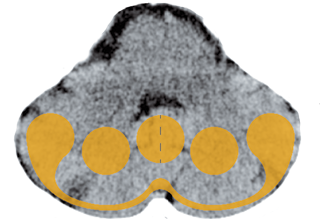

Nerve cells
Myelin sheath
Touch or pain conflict
“Nerve tumor“ (neurofibroma)1
In the peripheral nervous system, the nerve projections (axons and dendrites) are bundles of nerve fibers. They are surrounded by protective myelin sheaths, formed of so-called Schwann cells. A neurofibroma is a “tumor“ of this connective tissue – like nerve sheath.
| Conflict | Touch or pain conflict. Conflict of perceiving touch as painful, unpleasant, or undesirable. Explanation: The most intense contact is a pain attack (impact, strike, fall, etc.). Also, bone pain can start this SBS. To protect the organ, the organism can “turn off“ the peripheral sensitivity (= pain). |
|---|---|
| Examples | ➜ A woman is beaten by her husband. ➜ Someone hits their head in a very painful manner.  Neurofibroma on the spinal column: A 66-year-old, married retiree is on a ski vacation when one night, he suddenly feels violent pain in the area of the thoracic vertebrae. With an MRI, a hazelnut-sized neurofibroma is diagnosed between the 7th and 8th thoracic vertebrae. Due to the dramatic pain, it is removed in a risky surgery. Conflict history: 2½ years ago, he climbs an apple tree to clean a birdhouse that he had once attached at a height of 3 meters. Unfortunately, he slips and falls onto a big branch, on his thoracic spine “one storey down,“ and from there, to the ground. In doing so, he suffers the “worst pain of his life“ = pain conflict. For two months, life is only bearable with the aid of pills = active-phase – growth of a neurofibroma. A little bump appears on his spine. Two and a half years later, the patient comes into healing, because he slowly forgets the accident. During his vacation, he distances himself from the place of the accident = beginning of the repair phase with degradation of the neurofibroma > inflammation, pain > surgery. (Archive B. Eybl) Neurofibroma on the spinal column: A 66-year-old, married retiree is on a ski vacation when one night, he suddenly feels violent pain in the area of the thoracic vertebrae. With an MRI, a hazelnut-sized neurofibroma is diagnosed between the 7th and 8th thoracic vertebrae. Due to the dramatic pain, it is removed in a risky surgery. Conflict history: 2½ years ago, he climbs an apple tree to clean a birdhouse that he had once attached at a height of 3 meters. Unfortunately, he slips and falls onto a big branch, on his thoracic spine “one storey down,“ and from there, to the ground. In doing so, he suffers the “worst pain of his life“ = pain conflict. For two months, life is only bearable with the aid of pills = active-phase – growth of a neurofibroma. A little bump appears on his spine. Two and a half years later, the patient comes into healing, because he slowly forgets the accident. During his vacation, he distances himself from the place of the accident = beginning of the repair phase with degradation of the neurofibroma > inflammation, pain > surgery. (Archive B. Eybl) |
| Conflict-active | Thickening of the myelin sheath at the affected spot via cell division of Schwann cells = neurofibroma. Thickening of the isolation layer leads to pain numbness (anesthesia). It is difficult to distinguish between this kind of numbness to pain and deafness in the active–phase of a separation conflict (see: p.332). |
| Bio. function | The thickening of the nerve isolation eases the intensity of the pain or unwanted touching and blocks off the pain. |
| Repair phase | Restoration of sensitivity with possible over-sensitivity at the beginning. The neurofibromas remain or are removed by bacteria. What remains is a bump. |
| Neuropathy | According to CM – a nerve disease. According to NM: convulsions, paralysis = SBS of the muscles, see. pp. 377. Numbness, tingling, pins and needles = SBS of the epidermis, pp. 332. |
| Questions | Is the location actually inflamed (healing) or “quiet” (active phase)? What happened at the location before (strike, impact, accident, spiritual injury)? Which conditioning plays a role? |
| Therapy | Determine the conflict and conditioning and resolve if possible (if it isn’t already resolved). Find out where the love is – there you’ll find the solution. Guiding principle: “A protective coat shelters me. I only let those who are good to me get close to me!“ Externally, St. John‘s wort oil, meadow flower decoction. If inflamed, compresses of sour clay, pot-cheese, white cabbage leaves, etc. Lymph drainage massages (see p. 68). MMS (see p. 68). Hildegard of Bingen: oil of violet. OP is risky. |
1 See Dr. Hamer, Charts, pp. 45, 50
Losses of consciousness, states of absence (blackouts, absences), absence seizures, autonomic seizures, fainting fits (syncope)
These sudden loss of consciousness for several seconds are more common in children. They can happen up to 100 times a day. Sometimes they are hardly noticed by the affected person.
Most important to understand is that here, we are definitely dealing with a Healing crisis. Now it becomes more difficult: Finding out which SBS is causing the absence (“nothing comes from nothing”). Below are the possible SBSs, listed in descending order of frequency. Classified based on the symptoms:
• Striated musculature – motor conflict. Note: Twitching, tics, cramps, restless legs, possibly local paralysis, see pp. 97, 378 The onset does not have to coincide with the seizure – the seizures usually occur during relaxation.
• Myocardium (heart muscle), coronary arteries, coronary veins – conflict of feeling overwhelmed, male or female territorial conflict. Note: Cardiac arrhythmia, heartbeat too fast or too slow, possibly heart attacks pp. 154, 151, 205.
• Ectodermal bladder mucosa, renal pelvis – territory marking conflict. Note: Bladder infections, sudden urge to urinate (overactive bladder), see: p.286.
• Ectodermal stomach mucosa, bile ducts – territory-anger conflict. Note: Gastritis, heartburn, fat intolerance, stomach and biliary colic, see pp. 233, 265.
| Conflict | The following conflict aspects could be resonating in the background: The situation is unbearable, one wants to ignore it. = Escape from reality into an “other dimension” where it is quiet and peaceful. |
|---|---|
| Examples |  A 15-year-old girl has been suffering from absences for years since a painful separation from her best friend as a nine-year-old (female territorial loss conflict – coronary veins, track: stress with friends or partners). When she has additional trouble at school, she would like nothing better than to “disappear.” At 16, while she slowly becomes a “woman,” her symptoms improve. There is a relapse when her parents have a falling out and separate. (Archive B. Eybl) A 15-year-old girl has been suffering from absences for years since a painful separation from her best friend as a nine-year-old (female territorial loss conflict – coronary veins, track: stress with friends or partners). When she has additional trouble at school, she would like nothing better than to “disappear.” At 16, while she slowly becomes a “woman,” her symptoms improve. There is a relapse when her parents have a falling out and separate. (Archive B. Eybl)  A retired nature-lover, who had worked in an office until recently, had a few losses of consciousness – diagnosed as “syncope.” Since the first, in which he totaled his car, he doesn’t dare drive anymore, although he had always loved driving with a passion. Conventional medicine couldn’t find a cause. From our point of view, his symptoms point to a persistent motor conflict: leg cramps, heavy twitching when falling asleep, jaw muscle tension. History: In the months before the car accident, he was under a lot pressure from a new boss. More than ever he felt “locked up”/robbed of his freedom in the office. = motor conflict “I want to get out of here, out into nature.” He resolves his conflict when he turns 60 and decides to reduce his hours at work. > Shortly afterward he had the accident. Another episode occurs in a similar constellation. He got his “being trapped conditioning” from his mother: She had gone on one trip after another after her husband died. Before that, she felt like she had been trapped her whole life. Therapy: Honoring his mother’s life and realizing that he is now fully free in his retirement. Transdermal magnesium, CBD oil. (Archive B. Eybl) A retired nature-lover, who had worked in an office until recently, had a few losses of consciousness – diagnosed as “syncope.” Since the first, in which he totaled his car, he doesn’t dare drive anymore, although he had always loved driving with a passion. Conventional medicine couldn’t find a cause. From our point of view, his symptoms point to a persistent motor conflict: leg cramps, heavy twitching when falling asleep, jaw muscle tension. History: In the months before the car accident, he was under a lot pressure from a new boss. More than ever he felt “locked up”/robbed of his freedom in the office. = motor conflict “I want to get out of here, out into nature.” He resolves his conflict when he turns 60 and decides to reduce his hours at work. > Shortly afterward he had the accident. Another episode occurs in a similar constellation. He got his “being trapped conditioning” from his mother: She had gone on one trip after another after her husband died. Before that, she felt like she had been trapped her whole life. Therapy: Honoring his mother’s life and realizing that he is now fully free in his retirement. Transdermal magnesium, CBD oil. (Archive B. Eybl) |
| Therapy | Determine and resolve the conflict and conditioning. With children, success has been achieved by switching to ketogenic foods or a Stone Age diet. See also therapy for muscle spasms p. 380. |
Inflammation of the brain (encephalitis)
According to CM, this is an infection by viruses or bacteria (e.g., borelia). The fact is, however, that the brain is the only germ-free region of the body. According to Dr. Hamer, a lumbar puncture (spinal tap) often leads to encephalitis.
| Conflict | Depends on the part of the brain. |
|---|---|
| Tissue | Brain and/or meninges. |
| Phase | Repair phase: Every Hamer focus in the repair phase causes some sort of encephalitis, especially when several conflicts go into healing at the same time, which happens often (spring-cleaning of the brain). This has nothing to do with “infection.“ |
| Therapy | The conflict is resolved. Support the repair phase. See: repair phase at the brain level, p. 67.. |
Hydrocephalus (water on the brain)
In the case of hydrocephalus, the ventricles for cerebrospinal fluid (CSF) (subarachnoid space) are widened because of a drainage disturbance caused by narrowing (stenosis), most often in the area of the 4th ventricle between the brainstem and the cerebellum.
| Conflict | Active refugee or existence conflict and possibly more conflicts in the repair phase (= syndrome). |
|---|---|
| Phase | Repair phase: One or more Hamer focus(i) in the brainstem or cerebellum cause swelling due to a very intensive repair phase with syndrome. |
| Therapy | Resolve the refugee or existence conflict. Support the repair phase. See: repair phase at the brain level, p. 67. In CM, during a shunt surgery, a small plastic tube is implanted into the brain so that fluids can drain. Surely, this is the last option that should be chosen when nothing else helps. |
All experience reports on the organ system « The Nervous System » from the International Report Archive:
| Author | Title and Overview | Keywords |
|---|

